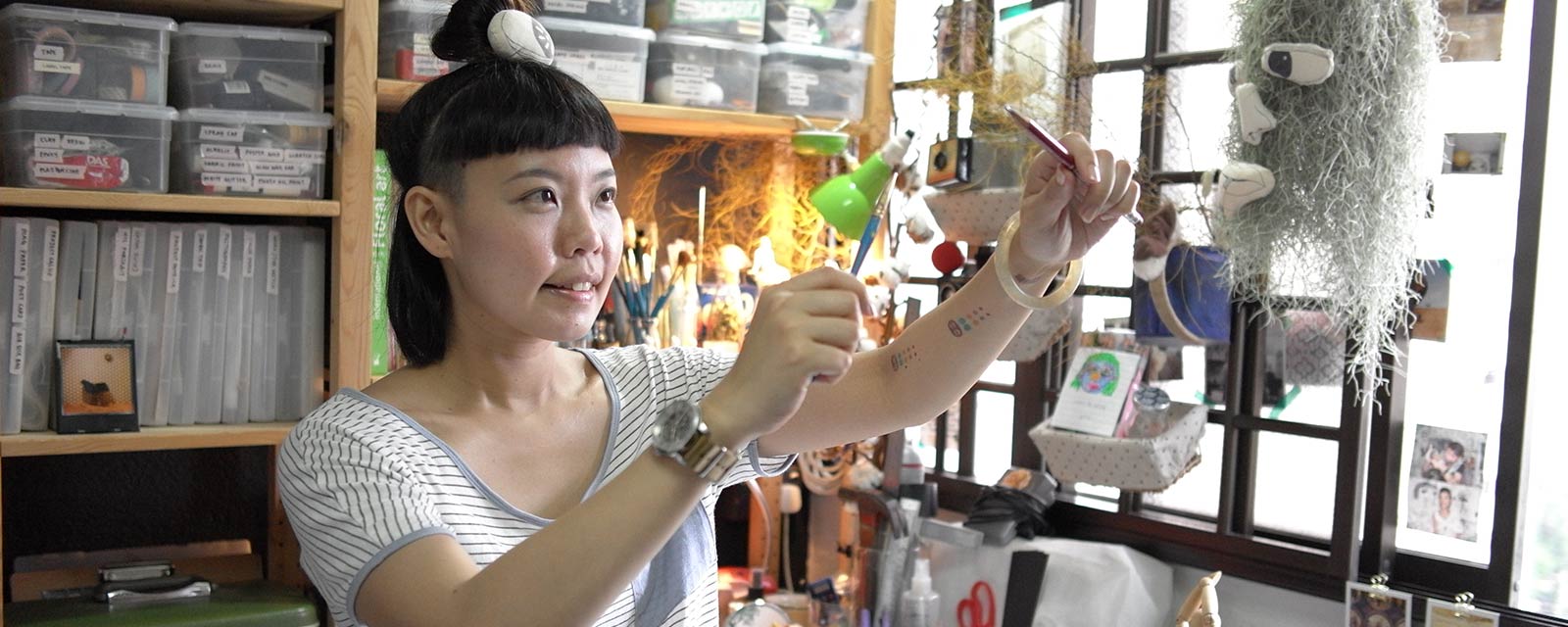
When it comes to describing Noreen’s artistic development, experimentation is the key word. From an early age she always knew that she wanted to do something crafty with her hands but really had no idea about what was possible. Working in different fields like floristry and exploring various materials not only strengthened her skills but also taught her a lot about herself.
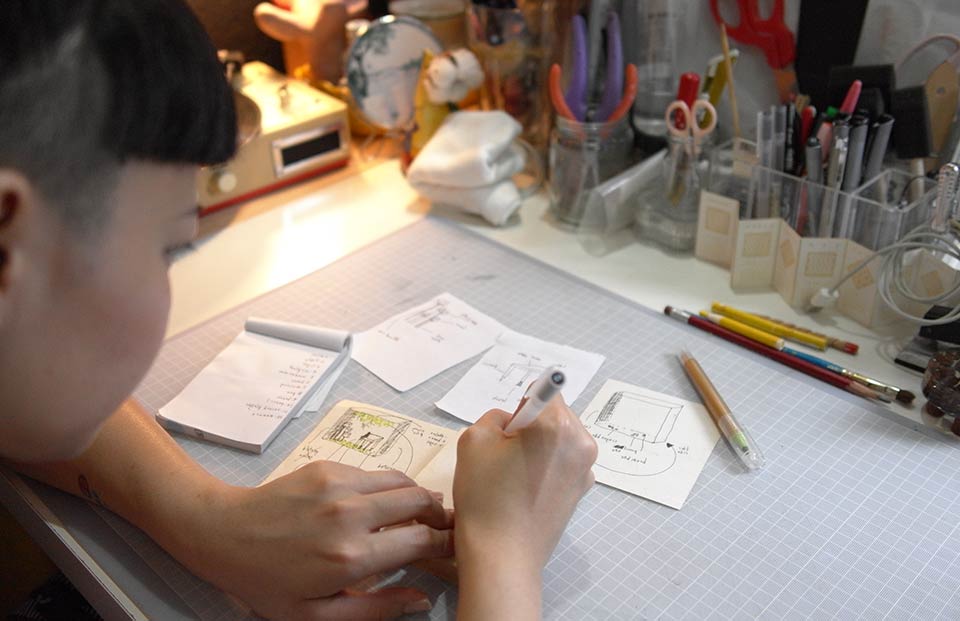
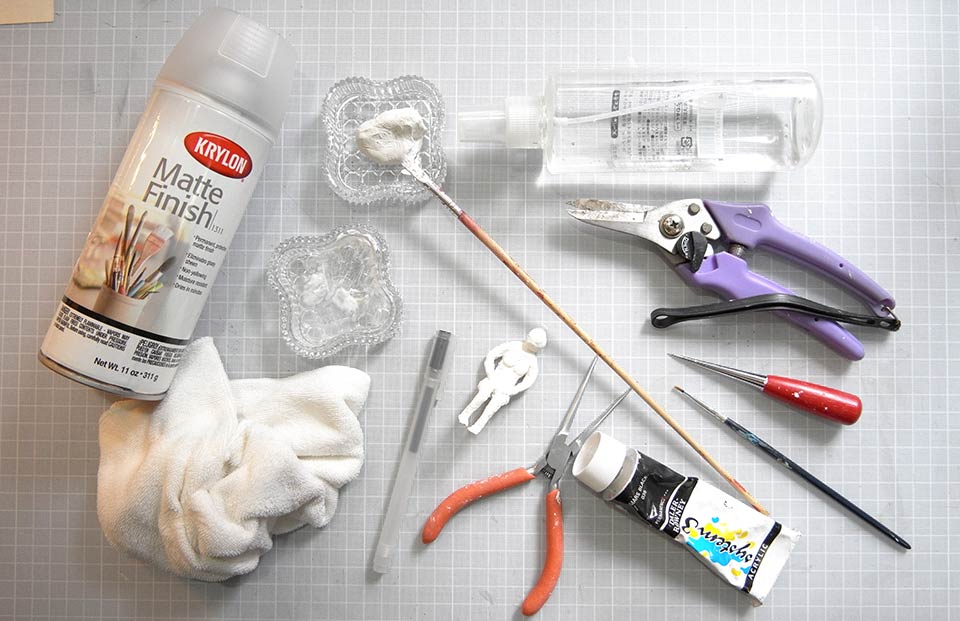
Mixing media like drawing, painting, sewing and photography is a huge part of Noreen’s identity and the result of a long journey of experimentation. At the beginning of her creative journey every piece looked as if a different person had made it because she was so torn between the various techniques. Step by step, she merged different techniques and media to create her very own personal style of art. The techniques she uses often originate from a traditional background and taking them to a whole new level by experimenting is a delightful challenge.
If people ask her whether she considers herself an artist or a craftswoman, she always tells them that she plans her work as an artist and executes it as a craftswoman. The importance of handcrafts often reveals itself to her when she sees how delighted people are when they’re confronted with something ‘real’ like her work. To be able to touch the material without swiping a touchscreen is something rare for many people these days. Keeping crafts alive means committing to all human senses.
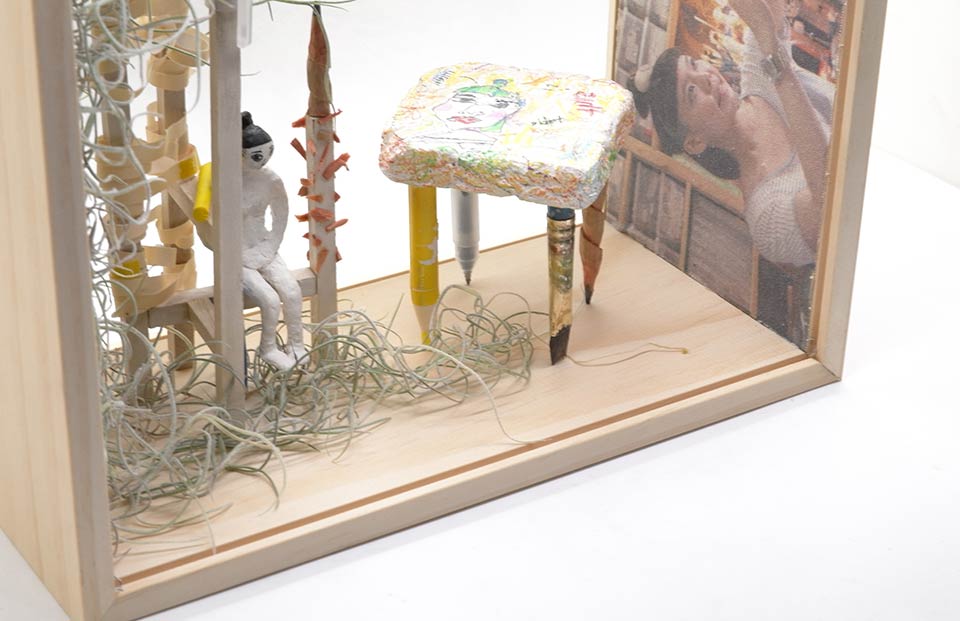
YOUR
Leica T
COLLAGE BOX EDITION
INTERVIEW
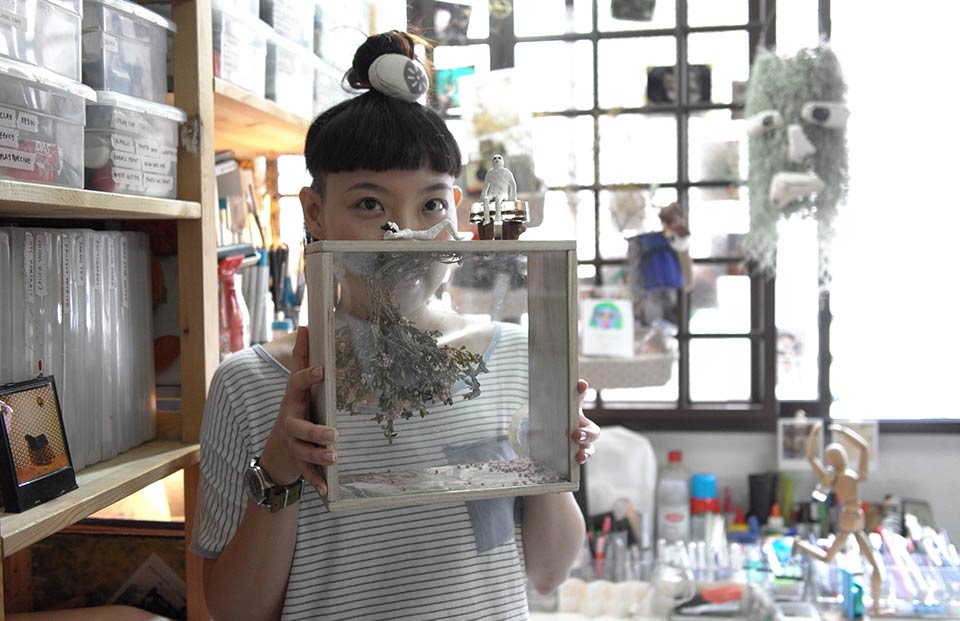
When and where were you born?
I was born on 2nd november 1981, in Perak, Malaysia, in a small town called Ipoh, a popular place known for its nice food. My name is Noreen Loh Hui Miun, and my artist name is Miun. It was spelled wrongly when i was born, its supposed to be spelled Min.
Where is your life centered at the moment?
I'm living in Singapore at the moment.
Where is your work centered at the moment?
I work part time for an analogue camera shop and after work I stay at home practicing my art, sometimes I do illustration freelance jobs, sometimes I work on requests for floral design jobs, sometimes if I have an idea, I just create a series of art work.
How old is your handcraft?
I would say it has been 6-7 years since I began exploring different media.
How, when and where did your handcraft find you first?
I first learnt that I wanted to create things with my hands when I was in art school (when I was 26 years old). We were asked to select a major and I already set my mind on going for jewelry design knowing that it will require a lot of hand craft and skills. But things did not work out as I planned and the school terminated the course one week before the class was supposed to start and I ended up deferring my studies and stumbled upon a creative assistant position at a floral shop. I began to fall in love with this new medium and my journey of exploring started from here.
Is it Love? Profession? Faith? Determination? Curse?
I would say I was born to love and enjoy my craft. I seriously did not know that I had such a pair of gifted hands when I was younger. I always did what I was told to do but I'm most happy when I'm sitting on the table creating art work. Fate comes along as well and it was never an easy road for me - there are times when people told me that I am such a talented floral designer and I should stick to that, but I enjoy all kinds of media and that’s when destiny is calling me. I stay with what I like and enjoy most and explore my own ways. I try all kinds of crafting material and explore, during this process I learn more about myself.
Please tell us more about the history / origin of your handcraft.
So I began as an art school drop out and ended as a floral creative assistant. The job was not as fantastic as I was told and I needed to run the shop alone after a 2 months training but I took the challenge and explored the medium researching about techniques on youtube. I drew the flowers in a book to remember the names of the flowers. I believe that if an object is given to me, I can use it in 101 different ways. Its not necessary to do it the traditional way. I love to keep on exploring and experimenting. After I quit the job at the floral shop I decided to create my own piece of work. From there I began to take 1-2 months off work and explore my identity, practice drawing, sewing, painting and photography as well, and now my handcraft is a combination from all these different media and genres.
Do you control or change your handcraft or does your handcraft control or change you?
I love to experiment!! Sometimes the medium is limited to what it can be what can be done with it or there is a certain rule that it has to be done in a traditional way but I usually try a lot of different ways to manipulate them and make them my own. I guess I'm the one controlling the handcraft.
How did your craft develop in the course of the past decades or centuries?
It has not even been a decade yet since I started my craft. In fact when I look at my work, every piece looks as if it was done by a different person. It’s like evolving a different personality with every piece. But slowly they are merging together.
How will your craft and you evolve together in the future?
Seriously I do not like to think too much about the future. I used to plan so much but always ended up in a disaster. I learnt to work at one thing at a time. I will just keep doing and crafting, I promised myself to make at least one series of work per year. Sometimes creating art can't feed me so I need to work part time which does not leave me much time for creating. So for now I just do my best in whatever I have in front of me, concentrate at one project at a time.
Which part of the production process do you like best and why?
I enjoy every single part of the process!!!! From concept to execution. Sometimes it works backwards, I have some ideas on the work and I need to track back to the concept, sometimes I have a concept and i need to think of the final execution. Either way, its a very fulfilling process. I love to think a lot, I can go to bed and wake up in the middle of the night when I suddenly have an idea and I need to try it out before I can go back to sleep. If I really have to choose then it would be the final touch / the end of the work when I complete everything because this feels like I have given birth to a baby!!
Which part of the production process is the most tricky one?
When starting with the initial idea / concept. Sometimes the idea and the vision I have feels like a.b.c but when realizing it, it goes c.b.a. So I have to be creative and I have to find a solution to make it a.b.c.
What is the biggest challenge?
Time and material! I have a day job and I can only do my art after work but I enjoy working in the quiet night. When it comes to material I love using plants or flowers, sometimes you have to wait a few days to know how they will turn out to after they dried.
How does it feel to transform digital pixels into real, tangible originals? It feels amazing, I'm an analogue person and I love to have interaction with most of my art series that I have done previously (like a child building a sand castle). Sometimes I feel as if this project was custom made for my craft.
Please define „crazy“!
I am not good with words but the best visual will be ME.. I'm going crazy answering these questions.
Are you left or right handed?
I am a righty! My mum trained me to use my right hand from young.
What is the most important tool for your work, other than your hands?
My table! I used to work on the floor when I did not have a proper work space, it was a total mess and disaster.
How do people react on your handcrafted products?
Most people i meet like them and love to play with them, they find it amusing I guess.
What is the importance of handcrafts in current times?
It’s really obvious that a lot of people lost touch with the innovative society. For example, interactive art, an art director saw my art work once and said this to me: „This is real!!! I can really touch and interact with it. Unlike digital where I am just swiping the screen.“ Digital devices take a lot of time away and I have to admit that I am into this too, but i try to balance it out and spend more time creating than doing nothing.
Do you consider yourself an artist or a craftsman?!
I’m an artist when i think and a craftsmen when i execute the work.
What is your favorite smell? Your favorite touch? Your favorite taste ? Your favorite sound? Your favorite dream?
Favorite smell : the fresh flowers!!!! It’s like paradise. Favorite taste : I’m a very sweet person and also a very salty person. Favorite sound : The old vinyl records, I'm not looking for perfect sound, its more like what I used to hear when i was a kid. I enjoy nature too, no city sound pollution. Favorite dream : Right now my dream is coming true!!! this is a dream project!!!
What inspires you most?
Everything around me inspires me, but i feel most inspired when I travel.
Who is your personal „handcraft jesus“ of all times?
There are so many artists and successful people that are so inspiring but I would go for my mum. My dad passed away when I was 2 years old and mum brought us up by herself. There are 3 crazy daughters! I'm the youngest. In fact I think I learned my craft from her, I used to help her out after school during my primary school days. She does many jobs! She sews kids shoes and I help her cutting the thread and some parts, and she does jeans pocket design where I help her draw the design. She sewed our clothes and she knitted our clothes too.
What would you recommend to somebody who wants to start learning your handcraft? How should he/she start?
First of all: is just do it! Go to the craft store / DIY store and look at all the available items, explore everything!!!! Experiment with everything!! I learned so much from youtube! (That is the best part the digital world world) There are a lot of classes available too, but if he / she wants to do something which fits themselves, they have to explore the material and find their own identity.
History
COLLAGE
Collage is an art with a long and rich history and can even trace its roots all the way back to 200BC, when paper was first invented in China. It wouldn’t gain true popularity until many centuries later, around the 10th century, when Japanese calligraphers began applying glued paper and texts to write the poems. The collage technique would still need another few hundred years for it to arrive in Europe - sometime during the 1200s. Its popularity continued to grow and grow and by the 1400s and 1500s, gold leaf panels began to appear in Gothic cathedrals. The work of English artist Mary Delany in the 1700s also shows examples of collage art. In the 1800s, amateur hobbyists began to use collage techniques in their books. Examples like these can be found throughout history, although some have argued that true collage cannot be found until 1900 when it appeared as part of the modernism movement.
Assemblage is like collage but in 3D. The word comes from the 1950s when the artist Jean Dubuffet created a collage made from butterfly wings. He called it assemblages d’empreintes. Before him, both Marcel Duchamp and Pablo Picasso had created pieces using found objects. The art form would find acclaim when, in 1961, the New York Museum of Modern Art hosted an exhibition entitled “The Art of Assemblage”. The curator, William C Seitz, defined it the assemblage pieces as “entirely or in part, their constituent elements are preformed natural or manufactured materials, objects, or fragments not intended as art materials.” Featured in the exhibition were artists such as Man Ray, Joseph Cornell, Picasso, Braque, Kurt Schwitters, Robert Rauschenberg, Marcel Duchamp and Dubuffet.